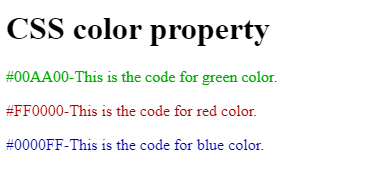In the vast landscape of web design, the CSS color property serves as a vibrant palette, allowing designers to infuse life and personality into websites. Whether you’re a novice or an experienced developer, understanding the intricacies of CSS color can elevate your design game to new heights. Let’s embark on a journey through the world of CSS color, exploring its nuances and applications.
Understanding the Basics
At its core, CSS (Cascading Style Sheets) color property is a fundamental building block of web design, offering an array of possibilities to control text, backgrounds, borders, and more. It empowers designers to paint the digital canvas, setting the mood and tone of a website. Moreover, it enhances user experience by providing visual cues and enhancing readability.
Choosing the Right Color
When selecting colors for your website, it’s essential to consider the psychology behind them. Transitioning from grayscale to vibrant hues can significantly impact how users perceive your site. For instance, warm colors like red and orange convey energy and urgency, while cooler tones like blue and green evoke tranquility and trust.
Color Representation
In CSS, colors can be represented in various ways. You can use predefined color names like “red” or “blue,” hexadecimal values like “#FF5733,” RGB values such as “rgb(255,87,51),” or even HSL (Hue, Saturation, Lightness) values. Each representation offers its unique advantages, depending on the context and your design goals.
Creating Gradients
Gradients are a stylish way to transition smoothly between two or more colors, giving your website an appealing and modern look. CSS provides the linear-gradient and radial-gradient properties, allowing you to craft intricate color transitions that captivate your audience. This technique is particularly useful for backgrounds, buttons, and headings.
Applying Transparency
Transparency can be a powerful tool in web design. With the rgba or hsla color notations, you can add transparency to your elements, creating subtle visual effects and layering content. This is especially valuable for overlays, hover effects, and creating visually engaging interfaces.
Handling Text Color
The text color plays a pivotal role in readability and aesthetics. When setting text color, ensure it contrasts adequately with the background to guarantee readability. Transitioning from a dark text color on a light background to the reverse can create visually pleasing results and enhance the overall user experience.
Color and Accessibility
Transitioning to an essential aspect of web design, accessibility, we must consider color choices. Accessibility guidelines emphasize the importance of ensuring that content is perceivable and understandable to all users, including those with visual impairments. This involves providing sufficient contrast between text and background colors, which can be achieved through thoughtful color selection.
Animating Colors
Adding subtle animations to your website elements can breathe life into your design. CSS provides the transition property, allowing you to smoothly transition between different color states. This technique is invaluable for creating engaging hover effects on buttons, links, and interactive elements.
Customizing Color Themes
CSS preprocessors like SASS and LESS take the customization of color themes to the next level. They allow you to define variables for your colors, enabling easy color changes throughout your stylesheet. This flexibility simplifies the process of rebranding or maintaining a consistent color scheme across your website. Play Keno online today and enjoy casino games thrills.
Cross-Browser Compatibility
Ensuring that your chosen colors render consistently across different web browsers is essential. CSS color properties are widely supported, but browser-specific quirks can sometimes affect how colors are displayed. Transitioning between different browsers for testing purposes can help you spot and address any compatibility issues.
CSS Color Property

Testing and Feedback
Transitioning from design to implementation involves rigorous testing and user feedback. It’s essential to gather input from real users to evaluate the effectiveness of your chosen color scheme. A/B testing, surveys, and usability studies can provide valuable insights that guide further refinements in your design.
Conclusion
The CSS color property is a versatile tool in the web designer’s toolkit, enabling them to create visually appealing, accessible, and engaging websites. From choosing the right color palette to mastering the art of transitions and animations, the color property offers endless possibilities. By understanding its nuances and best practices, you can elevate your web design skills to create remarkable online experiences.

